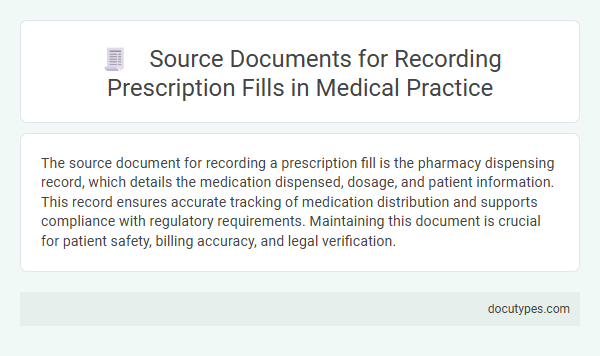The source document for recording a prescription fill is the pharmacy dispensing record, which details the medication dispensed, dosage, and patient information. This record ensures accurate tracking of medication distribution and supports compliance with regulatory requirements. Maintaining this document is crucial for patient safety, billing accuracy, and legal verification.
Introduction to Prescription Source Documents
Prescription source documents are essential records used in healthcare to accurately track medication dispensing. They serve as the primary reference for pharmacists and healthcare providers when filling and verifying prescriptions.
These documents include prescription orders, pharmacy labels, and medication administration records. Your understanding of these sources ensures proper medication management and patient safety.
Legal Requirements for Prescription Records
| Aspect | Details |
|---|---|
| Definition of Source Document | The source document for recording a prescription fill refers to the original record used to document the dispensing of medication to a patient. This includes prescription labels, electronic prescription records, and pharmacy dispensing logs. |
| Legal Requirements for Prescription Records | Pharmacies and healthcare providers must maintain accurate and complete prescription records in compliance with state and federal regulations, including the Controlled Substances Act and HIPAA for patient privacy and security. |
| Retention Period | Prescription records must be retained for a minimum period, commonly between 2 to 7 years depending on jurisdiction, to ensure availability for audits, legal inquiries, and patient care reviews. |
| Record Accuracy | Records must accurately reflect the medication dispensed, dosage, quantity, date of fill, and the dispensing pharmacist's identification to meet legal standards. |
| Electronic Prescription Records | Electronic Health Records (EHR) and e-prescribing systems must comply with federal mandates on encryption, secure access, and audit trails to protect your prescription data. |
| Audit and Compliance | Regulatory bodies may conduct audits to verify compliance with prescription record-keeping standards, emphasizing the need for thorough documentation in source documents. |
Types of Prescription Source Documents
The source document for recording a prescription fill is essential in ensuring accuracy and compliance in medical record-keeping. You rely on these documents to verify and document medication dispensed to patients.
- Written Prescription - A manually signed document by the prescriber detailing medication instructions for the patient.
- Electronic Prescription (e-prescription) - A digitally generated and transmitted prescription from healthcare providers to pharmacies.
- Faxed Prescription - A prescription sent via fax as a paper copy, serving as a legal record for medication dispensing.
Each type of prescription source document plays a vital role in maintaining accurate pharmacy records and ensuring patient safety.
Electronic vs. Paper Prescription Records
The source document for recording a prescription fill varies between electronic and paper prescription records. Understanding this difference ensures accurate documentation and compliance in medical practice.
- Electronic Prescription Records - The pharmacy information system automatically generates and stores digital data when a prescription is filled.
- Paper Prescription Records - The physical prescription form serves as the primary source document and must be retained after the medication is dispensed.
- Legal and Regulatory Compliance - Both electronic and paper records must meet specific state and federal requirements for accuracy and retention.
Key Information Captured in Prescription Fill Records
The source document for recording a prescription fill is the pharmacy dispensing record, which includes detailed information about the medication provided to the patient. Key information captured in prescription fill records includes the patient's identification, medication name, dosage, quantity dispensed, and date of fill. This data ensures accurate tracking of medication usage and supports safe and effective patient care.
Best Practices for Accurate Prescription Documentation
What Is the Source Document for Recording a Prescription Fill? The source document for recording a prescription fill is the original prescription or electronic prescription received from the healthcare provider. Accurate documentation involves verifying prescription details such as medication name, dosage, quantity, and date of fill to ensure patient safety and regulatory compliance.
Importance of Source Documents in Medication Safety
The source document for recording a prescription fill is the original prescription written by the healthcare provider. This document serves as the primary reference to ensure accuracy in dispensing the correct medication and dosage. You rely on these records to maintain medication safety and prevent errors during treatment.
Auditing and Compliance in Prescription Recordkeeping
The source document for recording a prescription fill is the original prescription or electronic prescription record. This document serves as the primary evidence of the medication dispensed to the patient, ensuring accuracy in prescription recordkeeping.
In auditing and compliance, the source document must clearly detail the medication name, dosage, quantity, and date of dispensing. Maintaining accurate prescription fill records protects against legal liabilities and supports regulatory adherence. Your pharmacy's audit trail relies heavily on these source documents to verify proper dispensing practices and to detect discrepancies.
Challenges in Maintaining Prescription Source Documents
The source document for recording a prescription fill is typically the original prescription or an electronic prescription record provided by the healthcare provider. Maintaining these source documents accurately is crucial for ensuring patient safety and regulatory compliance.
Challenges in maintaining prescription source documents include issues such as document integrity, timely updates, and data accessibility across healthcare systems.
- Document Integrity - Ensuring that the source documents are free from alterations and accurately reflect the prescribed medication.
- Timely Updates - Updating the prescription records promptly after each fill to maintain accurate medication histories.
- Data Accessibility - Facilitating secure and consistent access to prescription information across different healthcare providers and pharmacies.
What Is the Source Document for Recording a Prescription Fill? Infographic

